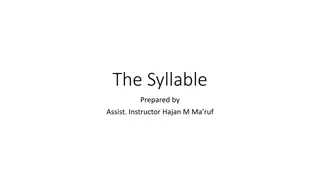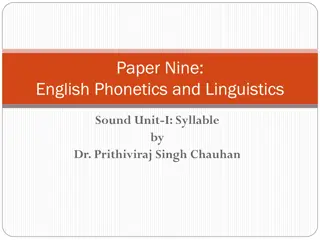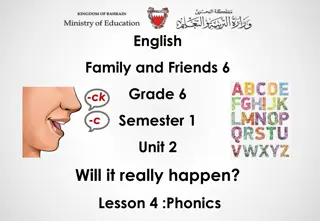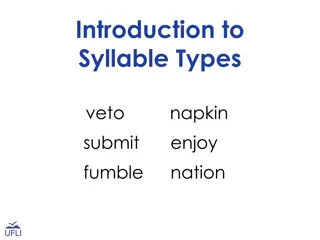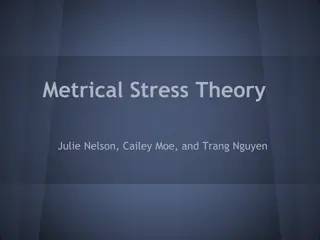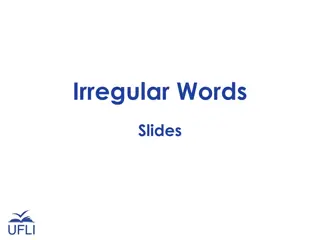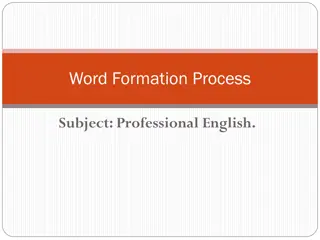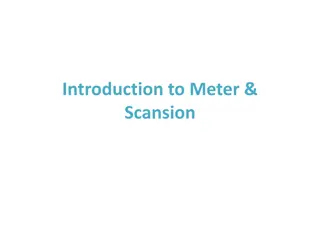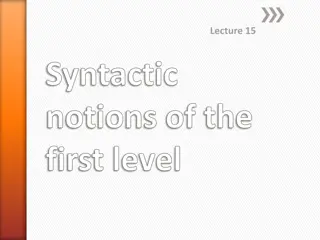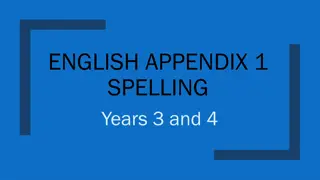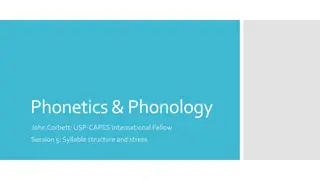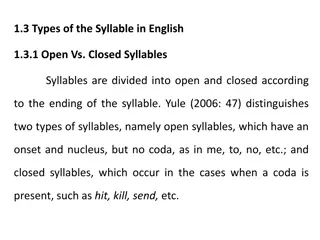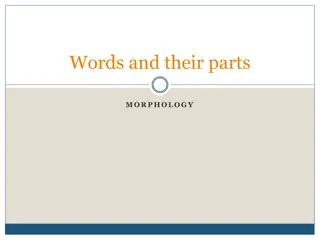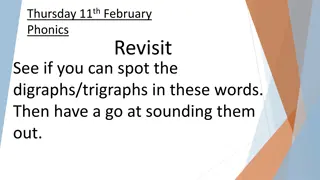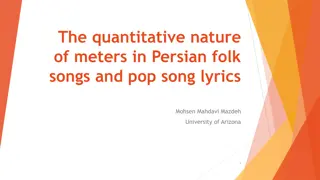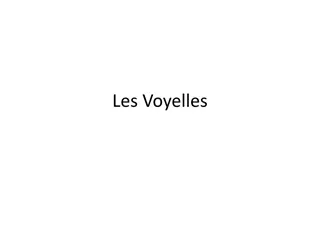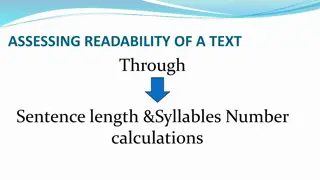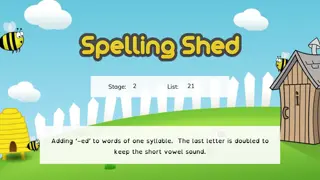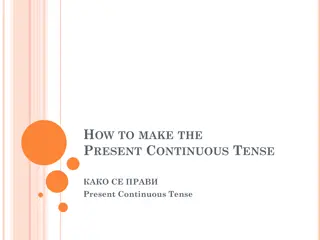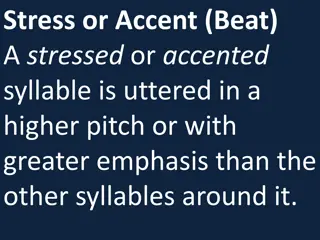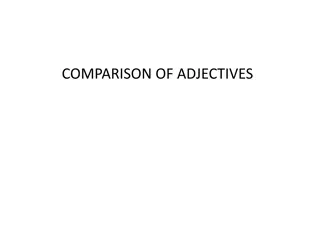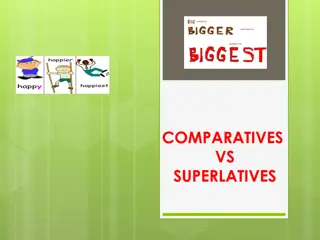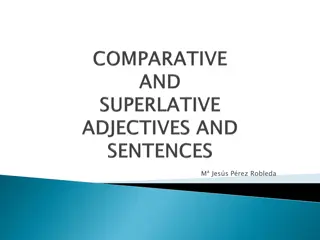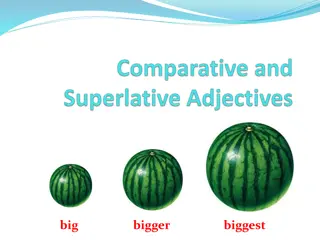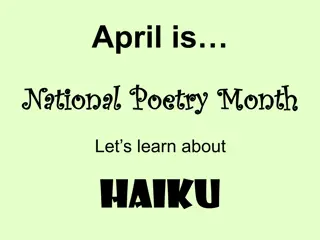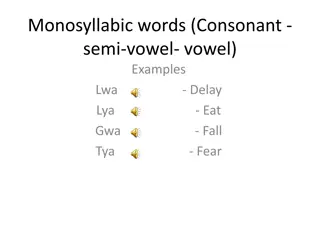Understanding English Syllables: Structure and Description
Explore the concept of syllables in English phonetics through an in-depth analysis of syllabic structure, sonority, constituents, rhyme, nucleus, coda, and phonological perspectives. Delve into the definition of a syllable, its importance in speech production, and the phonetic descriptions of syllab
2 views • 38 slides
Understanding the Importance and Nature of Syllables
Syllables play a crucial role in speech rhythm, yet their definition and identification can vary among individuals. The nature of syllables, encompassing vowels, consonants, onsets, and codas, can be analyzed phonetically and phonologically. This article explores syllable structures and phonotactics
2 views • 18 slides
Understanding English Syllables: Phonetics and Linguistics Insights
Explore the concept of syllables in English phonetics and linguistics, learning about syllable formation, examples of mono and disyllabic words, and the role of vowels and consonants in syllable structure. Delve into the essence of syllables as individual sound units within words. Discover more thro
11 views • 8 slides
Phonics Lesson for Grade 6: Words ending with "-ck" and "-c
This lesson focuses on identifying and spelling words ending with "-ck" and "-c," as well as using them accurately in sentences. Students will practice words like duck, picnic, music, neck, plastic, comic, rock, and clock. Activities include completing words with "c" or "ck," practicing spelling, an
1 views • 9 slides
Introduction to Syllable Types
Delve into the world of phonetics with this informative content explaining vowel sounds, consonant sounds, and the concept of syllables. Discover the differences between short and long vowel sounds, voiced and unvoiced consonants, and how syllable types can aid in pronunciation. Engage in interactiv
2 views • 31 slides
Understanding English Morphology: The Study of Words and Meaning
English Morphology delves into the structure of words, exploring morphemes as the building blocks of linguistic meaning. From free morphemes like "certain" to bound morphemes like "-ly," the discipline uncovers how words are constructed and adapted grammatically. By examining the derivational and in
0 views • 49 slides
Exploring Metrical Phonology: A Brief Overview
Metrical phonology, a subtheory of generative phonology, focuses on categorizing stress and stress rules within rhythmic hierarchies. It differs from generative phonology by not treating stress as a segmental feature specific to vowels. Originating from Halle's linear analysis, metrical stress theor
1 views • 32 slides
Irregular Words: Learn and Review Commonly Used Words
This text provides a list of irregular words commonly used in English. It includes words like "the," "has," "were," and "know." Practice and remember these words to improve your vocabulary and language skills.
0 views • 169 slides
Various Word Formation Processes in Professional English
Coinage, Borrowing, Compounding, Derivation, Blending, Backformation, and Acronym are key mechanisms for forming new words in Professional English. Coinage involves inventing new words, Borrowing uses words from foreign languages, Compounding combines words to create new ones, Derivation adds prefix
0 views • 11 slides
Understanding Dactylic Hexameter in Latin Poetry
Latin poetry employs a rhythmic structure known as meter to enhance meaning and poetic effect. Particularly, dactylic hexameter is a prevalent meter in ancient epic poetry, consisting of six feet predominantly made up of dactyls—a long syllable followed by two short syllables. Scanning dactylic he
0 views • 9 slides
Understanding Monosyllabic Words in Luganda
Monosyllabic words in Luganda come in various forms, including vowels as exclamations or questions, consonant-vowel words with complete meanings, nasal-consonant-vowel words, double consonant-vowel words, and more. These words play different roles in expressing surprise, asking questions, or conveyi
0 views • 8 slides
Syntactic Notions of the First Level in Linguistics
In this lecture, the syntactic notions of the first level in linguistics are discussed, focusing on word groups, simple sentences, and the essential features of actual division. The different types of syntagmatic groupings of words, such as notional words, functional words, and their combinations, a
1 views • 19 slides
English Spelling Rules and Prefixes Guide for Years 3 and 4
Improve your English spelling skills with this comprehensive guide for Years 3 and 4. Learn how to add suffixes to multi-syllable words, understand the various vowel sounds, and master common prefixes. Enhance your vocabulary and writing with examples and rules provided in an easy-to-follow format.
1 views • 22 slides
Understanding Syllable Structure and Stress in Phonetics and Phonology
Explore the concepts of syllable structure and stress in phonetics and phonology through examples like analyzing the number of syllables, phonemes, and stress patterns in words. Dive into syllable boundaries, onsets, nuclei, and rhymes in words and phrases to deepen your understanding of English pho
0 views • 35 slides
Mastering Present Tense - Irish Verbs Practice Guide
Explore how to conjugate 1-syllable broad verbs in the present tense in Irish, including forming questions and negatives. Practice conjugation with examples and learn the rules for adding endings to verb roots. Enhance your understanding of everyday language use.
1 views • 6 slides
Understanding Syllable Types in English Language
Syllables in English are categorized into open and closed syllables based on their endings. Open syllables have an onset and nucleus without a coda, while closed syllables include a coda. Additionally, syllables can be simple (with a vowel or single consonant) or complex (with consonant clusters). T
1 views • 6 slides
Mastering 1-Syllable Slender Verbs in Irish Past Tense
Learn the rules for forming the past tense of 1-syllable slender verbs in Irish, including adding a s.imhi (h) after the first letter, using Ar to ask questions, and N or to form negatives. Practice with examples and easy-to-follow instructions for each verb type.
0 views • 6 slides
Irish Grammar: Past Tense Verbs - Rules and Examples
Learn about forming the past tense of 1-syllable broad verbs in Irish grammar. Understand when to use "h," "d," or "dh" before verbs starting with consonants, vowels, or "f." Discover how to ask questions and form negatives in the past tense, with helpful examples provided.
0 views • 6 slides
Present Tense Verbs in Irish Grammar: Everyday Usage & Structure
Explore how to form and use present tense verbs in everyday Irish language with 2 to 2-syllable broad verbs, including rules for endings and changes. Learn how to ask questions, form negatives, and practice verbs for buying, hurting, and cycling with clear examples.
1 views • 6 slides
Understanding Words and Their Parts in Morphology
Explore the world of words and their parts in morphology through exercises, classifications of word classes, differentiation between content words and function words, analysis of words beginning with "b," homonyms, polysemy, and verb inflection. Delve into the various aspects of linguistics to enhan
0 views • 49 slides
Phonics Revisit: Digraphs and Tricky Words Practice
Explore digraphs and trigraphs in words like "growl," "frown," "spear," and practice sounding out tricky words such as "come," "they," and "when." Learn about the sounds "ei" and "eigh" making the "ay sound" and practice spelling words like "eight," "eighty," and "neighbour." Test your memory with a
0 views • 9 slides
Exploring Quantitative Meters in Persian Folk Songs and Poetry
Delve into the quantitative nature of meters in Persian folk songs and pop song lyrics as discussed by Mohsen Mahdavi Mazdeh at the University of Arizona. The study explores how syllable weight, vowel length, and metrical patterns play vital roles in classical Persian poetry and the poetry of spoken
0 views • 19 slides
Understanding the Pronunciation of the Vowel "i" in French
The French vowel "i" has two pronunciations, similar to the English sounds in "feet" and "yes." The first pronunciation involves spreading the lips and raising the tongue close to the front of the mouth, creating a high front vowel sound. The second pronunciation occurs when "i" is followed by anoth
0 views • 6 slides
Understanding Text Readability Through Sentence Length and Syllable Calculations
Analyzing text readability involves calculations such as sentence length and syllable count to determine the grade level of a text. Methods like the Gunning FOG Readability Test utilize formulas or graphs to provide numerical values representing the text's complexity, which can be converted to readi
0 views • 34 slides
Mastering -ed Suffix in One-Syllable Words
Learn how to add the -ed suffix to one-syllable words by doubling the last letter to maintain the short vowel sound. Engage in activities to practice spelling words like patted, hummed, and clapped. Enhance your skills through exercises and unscrambling tasks. Perfect your understanding of this spel
0 views • 8 slides
Understanding the Present Continuous Tense
Explore how to form the Present Continuous Tense using the present simple of 'be.' Learn how to create affirmative, negative, and interrogative forms, including 'wh-' questions. Discover the spelling rules for verbs ending in 'e,' short one-syllable verbs, and those ending in 'ie.'
0 views • 17 slides
Mastering Past Tense in Irish Grammar: 2-Syllable Broad Verbs
Understand the rules for forming the past tense with 2-syllable broad verbs in the Irish language, from identifying broad and slender verbs to asking questions and forming negative statements. Learn step-by-step processes and useful tips to enhance your grasp of the past tense.
0 views • 5 slides
Understanding the Influence of Words on Sound Recognition in Interactive and Non-interactive Models
Influence of words on sound recognition differs in interactive and non-interactive models. In interactive models, sounds activate words in the mind in a feedback loop, while in non-interactive models, two routes exist to recognize a sound, one through words and the other directly through sounds. Thi
0 views • 6 slides
Understanding Poetry Meter and Verse Types
Explore the various aspects of poetry meter and verse types including stress or accent, accentual verse, syllabic meter, and accentual-syllabic verse. Learn about stressed/accented syllables, rhythmical patterns, syllable counting, types of feet in poetry, and examples of different metrical structur
0 views • 18 slides
Understanding the Comparison of Adjectives and Their Forms
Learn how to form comparatives and superlatives of short and long adjectives, including one-syllable, two-syllable, and irregular adjectives. Discover the rules for adding endings like -er, -est, more, and most, along with examples and comparison structures using "than". Master the correct spelling
0 views • 11 slides
Understanding Glottalisation of /t/ in English Phonology
Exploring the phonological process of glottalisation affecting the /t/ sound in English, focusing on intervocalic environments and beyond. The case study delves into word-final and word-medial positions, highlighting nuances in pronunciation and teaching points for syllable stress and articulation c
0 views • 13 slides
Effective Strategies for Word Study in Text Analysis
Explore common fallacies in word study such as the English-Only Fallacy, Root Fallacy, Time-Frame Fallacy, and Over-load Fallacy. Learn how to overcome these fallacies by giving context priority and using concordances. Discover practical steps to choose words for study, including looking for critica
0 views • 7 slides
Understanding Iambic Pentameter: Shakespeare's Versification
Iambic Pentameter is a verse rhythm popular in Shakespearean works, featuring 10 syllables per line with alternating stressed and unstressed beats. It distinguishes high-class characters from lower-class ones and allows for creative variations by changing stress patterns and adding syllables. An Iam
0 views • 47 slides
Understanding Comparatives and Superlatives in Adjectives
Learn about comparatives and superlatives in adjectives, including examples of short and long adjectives, as well as irregular forms. Discover how to form comparative and superlative adjectives with one-syllable and multi-syllable words. Gain insights into common irregular adjectives like good, bad,
0 views • 7 slides
Rules for Forming Comparative and Superlative Adjectives
Learn the rules for forming comparatives and superlatives of adjectives based on syllable count and endings. Understand the spelling conventions and exceptions for one, two, and three-syllable adjectives, as well as irregular adjectives. Master the comparative and superlative forms to enhance your E
0 views • 11 slides
Understanding Adjective Comparison in English Grammar
Explore the rules for forming comparative and superlative forms of adjectives in English grammar. Learn about irregular comparisons, one-syllable adjectives, adjectives ending in -y, -ow, -le, -er, multi-syllable adjectives, hyphenated adjectives, and more. Discover the nuances of adjectives with on
0 views • 14 slides
Comparatives and Superlatives of Adjectives: Rules and Examples
Learn how to form comparative and superlative forms of one-syllable and two-syllable adjectives, including rules for adding suffixes, doubling consonants, ending with "y", and irregular adjectives. Examples and images included for easy understanding.
0 views • 7 slides
Explore Haiku Poetry in National Poetry Month
Discover the art of haiku poetry during National Poetry Month. Learn about the structure of haiku, explore featured haikus, and engage in activities to understand and create your own haikus. Dive into the world of nature-inspired verses with syllable counting and animal-themed haikus.
0 views • 10 slides
Overview of NLP Word Distributions and Stop Words
Introduction to NLP discusses how words are not evenly distributed using examples like the 80/20 rule. The distribution of words in Shakespeare's "Romeo and Juliet" is highlighted, showing common word frequencies. Additionally, Stop Words Fact explains how common English words dominate text composit
0 views • 14 slides
Exploring Monosyllabic and Polysyllabic Words in Luganda
Discover the structure of monosyllabic words in Luganda consisting of consonant-semi-vowel-vowel patterns like Lwa and Gwa, as well as those with consonant-consonant-semi-vowel-vowel patterns like Mbwa and Nswa. Further explore the realm of polysyllabic words in Luganda, where each syllable ends wit
0 views • 4 slides

